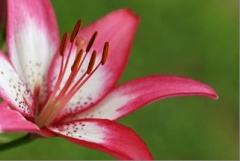Difference between revisions of "Lily, Asiatic Lily, Oriental lily"
(Created page with "{{Infobox_Other_organic | image = Lily.jpg | origin = - | stowage factor = - | humidity and moistu...") |
|||
| Line 24: | Line 24: | ||
====Special Considerations==== | ====Special Considerations==== | ||
Proper cultivar selection and the use of anti-yellowing postharvest chemical treatments (available commercially in some markets) can diminish leaf yellowing. STS or 1-MCP only reduce leaf yellowing caused by exposure to ethylene. Lily pollen can stain almost anything; removing stamens containing the pollen does not affect flower life. Some new cultivars do not shed pollen. | Proper cultivar selection and the use of anti-yellowing postharvest chemical treatments (available commercially in some markets) can diminish leaf yellowing. STS or 1-MCP only reduce leaf yellowing caused by exposure to ethylene. Lily pollen can stain almost anything; removing stamens containing the pollen does not affect flower life. Some new cultivars do not shed pollen. | ||
| + | <br><br><br> | ||
| + | <b>Sources used</b><br> | ||
| + | BMT De [[Beer]]’s Consolidated Manual on (Dutch) [[Flower Bulbs]], cut flowers/greens and potted [[plants]] | ||
| + | [[Category: Products]][[Category: Perishables]] | ||
Revision as of 08:28, 16 August 2013
| Infobox on Lily, Asiatic Lily, Oriental lily | |
|---|---|
| Example of Lily, Asiatic Lily, Oriental lily |  |
| Facts | |
| Origin | - |
| Stowage factor (in m3/t) | - |
| Humidity / moisture | - |
| Ventilation | - |
| Risk factors | See text |
Lily, Asiatic Lily, Oriental lily
Contents
Description / Shipment / Storage / Risk factors
Scientific Name and Introduction
Lilium spp. Lilies have long been popular as garden flowers, prized for their stately beauty, and potted white lilies are a tradition in countries that celebrate Easter or Christmas. The brightly coloured flowers of hybrid lily cultivars have become increasingly popular as cut flowers and have excellent vase-life, especially if pretreated to prevent effects of ethylene. Buds open well if provided with preservative. Lilium is from the Greek word lirion, used in the naming of certain subdivisions of the genus.
Quality Characteristics and Criteria
Lilies are normally cut when one or two buds are just beginning to "crack." Tight-bud stage flowers take some time to open, and petals of open flowers are likely to be damaged during transport. Most species and cultivars should be purchased with colour showing on at least one flower. Avoid bunches with a number of open flowers, since they probably have been held at warmer temperatures during marketing.
Grading and Bunching
Although there are no grade standards for lilies, the number of buds per stem, the stage of maturity, and the colour and quality of the foliage are all important quality parameters. Flowers are normally bunched in groups of 5 or 10.
Ethylene Sensitivity
Exposure of lilies to ethylene results in petal abscission, leaf yellowing, and abortion of young buds.
Pretreatments
After harvest, lilies should be treated with STS or 1-MCP to extend their vase-life.Pulsing with a preservative solution containing 10% sucrose can improve subsequent bud opening, and it is also possible to reduce postharvest leaf yellowing in susceptible cultivars by pre-treating them overnight with 2000 ppm GA3.
Storage Conditions
Lilies should be stored at 0°C to 1ºC. If flowers are to be stored for any length of time, they should be treated prior to storage with STS or 1-MCP and an appropriate fungicide, the latter to protect against Botrytis. Lilies can be stored for up to 4 weeks if they are pulsed for 24 h with 1,6 mM STS + 10% sucrose and then stored dry at 1ºC. Flowers should be properly pre-cooled, and they must be packaged so that water loss during storage is minimized (wrap pre-cooled flowers in polyethylene film). However, some problems with leaf browning and/or yellowing can occur even after 2 weeks storage.
Packing
Lilies are normally packed in horizontal fibreboard boxes.
Special Considerations
Proper cultivar selection and the use of anti-yellowing postharvest chemical treatments (available commercially in some markets) can diminish leaf yellowing. STS or 1-MCP only reduce leaf yellowing caused by exposure to ethylene. Lily pollen can stain almost anything; removing stamens containing the pollen does not affect flower life. Some new cultivars do not shed pollen.
Sources used
BMT De Beer’s Consolidated Manual on (Dutch) Flower Bulbs, cut flowers/greens and potted plants











